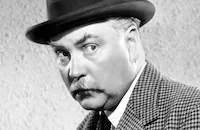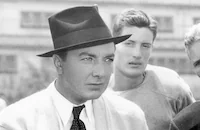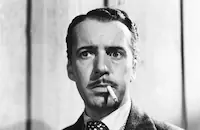Frenchman's Creek

Brief Synopsis
Cast & Crew
Mitchell Leisen
Joan Fontaine
Arturo De Córdova
Basil Rathbone
Nigel Bruce
Cecil Kellaway
Film Details
Technical Specs

Synopsis
In 1668, in London, Dona St. Columb, who is bored with city life, leaves her husband Harry when he refuses to acknowledge, and protect her from, the lecherous advances of his friend, Lord Rockingham. Dona takes her two children to Harry's ancestral home on the coast of Cornwall, where she is surprised to find only William, a servant unfamiliar to her. Dona laughs at her neighbor, Lord Godolphin, when he warns her of the treacherous French pirates who have been raiding the homes along the coast, but she is then kidnapped and taken to a pirate ship, La Mouette , that has dropped anchor in her own cove. Dona is thrilled by the presence of the pirate captain, who is known to her only as "The Frenchman," and invites him to her home for dinner. Although she is aware that Godolphin is forming a vigilante group to capture the pirates, Dona accepts The Frenchman's invitation to sail with him, and she leaves her children in the care of William. Wearing men's clothing, Dona narrowly escapes capture when she helps The Frenchman steal a French schooner laden with goods from Godolphin's cousin. Dona and The Frenchman fall in love, and when she finally returns home, she discovers that Harry and Rockingham have arrived to help Godolphin capture the pirates. William has covered for Dona's absence by telling her husband that she was sick in bed and could allow no visitors, and on Dona's urging, William goes to warn The Frenchman to set sail immediately. William delivers his message, but is shot in the arm by vigilantes, and returns to Dona to tell her that La Mouette will not be able to sail until midnight. That night, vigilantes gather at Dona's house for dinner, and she tries to detain them past midnight. The Frenchman and his men unexpectedly take the party hostage, and Rockingham becomes suspicious when he sees the loosely concealed familiarity between Dona and The Frenchman. The Frenchman bids farewell to his lady and, after the pirates make their escape, Rockingham jealously tries to force himself on Dona, who kills him in self-defense. The vigilantes, meanwhile, engage in battle with the pirates. The Frenchman allows himself to be captured in order to save his ship, but the ship stays nearby and Dona helps him escape from prison. Dona is tempted to leave her dull life to join The Frenchman, but chooses instead to remain with her husband and children, and The Frenchman sails away.

Director

Mitchell Leisen
Cast

Joan Fontaine
Arturo De Córdova

Basil Rathbone

Nigel Bruce

Cecil Kellaway

Ralph Forbes
Harald Ramond
Billy Daniels
Moyna Macgill
Patricia Barker
David James
Mary Field
David Clyde
Charles Coleman
Paul Oman
Arthur Gould-porter
Evan Thomas
Leslie Denison
Denis Green
George Kirby
David Thursby
Lauri Beatty
Ronnie Rondell
George Barton
Victor Romito
Robert Clarke
Allen Pinson
Patrick Desmond
Jimmy Dime
Harvey Easton
Henry Escalante
Art Foster
Vincent Gironda
Jacques Karre
John Latito
Rube Schaffer
Sammy Stein
Armand Tanny

Fred Kohler Jr.
John Roy
Neal Clisby
Noble Blake
Constance Worth
Phyllis Barry
Edward Cooper
Bob Stevenson
Alfred George Ferguson

Charles Irwin
Frank Hagney
Gordon Richards

Boyd Irwin
David Cavendish
Leyland Hodgson
Kenneth Hunter
Arthur Mulliner
Keith Hitchcock
Leonard St. Leo
Jerry James
Alice Kirby
Louise La Planche
Charles Mayon
Fred Nay
Marcella Phillips
Hal Rand
Albert Ruiz
Audrey Westphall
Betty Walker
Crew
Fred Alles
Julio Alonso
B. Ambler
Marion Bach
George Barnes
Martin Baumeister
Russell Bennett
Fred Bergamo
Raoul Pène Du Bois
Nick Borgani
Richard Brandow
Vincent Bratton
C. Brenner
Thad Brooks
Robert Brower
Arnold Brown
F. Busselles
F. Carroll
Harold Clemens
Herb Coleman
William Collins
Sam Comer
Irving Cooper
Hazel Croft
Lonnie D'orsa
Claude Debussy
Jack Degolconda
B. G. Desylva
H. Detter
Carmen Dirigo
George Dockstader
Don Donaldson
Leonard Doss
C. Dowhen
Hans Dreier
Farciot Edouart
Capt. Fred Ellis
E. Farmer
Ernst Fegté
Lyle Figland
Lila Finn
Bud Fraker
Dwight Franklin
Jack Fugua
W. Gaisford
Cecil Gardiner
M. Gardner
Charles Gemora
Maurice Goodman
Robert Goodstein
Steven Green
Hilda Grenier
J. Grindstaff
Al Grosser
Hazel Haggerty
Wesley Haight
Grace Harris
Charles Head
J. Helman
Ray Herrick
B. Hijbal
F. Hijbal
George Hill
Warren Hoag
Harry Hogan
Walter Huber
W. Hurley
Andrew Jack
Gordon Jennings
Talbot Jennings
Don Johnson
C. L. Jones
Clem Jones
Natalie Kalmus
Mme. [barbara] Karinska
Frank Kauffman
C. Kelly
Charles Kelly
Howard Kelly
J. H. Kerr
Robert King
H. Kraft
F. Kral
Roy Larson
Jack Leffman
Mitchell Leisen
David Lewis
Harold Lierly
Phyllis Loughton
Alma Macrorie
Louis Madsen
G. Mahoney
Nellie Manley
John Mari
T. Mcirvin
Donald Mckay
Richard Mcwhorter
John Meehan
Harry Merland
Otto Metzetti
Jim Moore
Cecil Myers
Aldo Nadi
Aldo Nadi
W. Newman
D. Norton
John Nostri
Olaf Oleson
Webb Overlander
George Parrish
Allen Pinson
Bud Pope
Adolph Prautsch
William Rabb
James Ratsonas
A. Reid
Rennie Renfro
Charles W. Robbins
I. Roberts
Victor Romito
Pierre De Ronsard
Leonora Sabine
Troy Sanders
Joe Schuster
Jack Semple
Venicia Severn
Ralph E. Shenk
J. Sherman
W. Sherman
Leo Shuken
Harry Smith
Kenneth Smith
B. Snodgrass
Capt. Somers
G. Spicer
Paul Stader
F. Steiner
Eleanor Stewart
Syd Street
Karl Struss
Paul Stuart
Walter E. Sullivan
Ken Swartz
Dick Talmadge
T. Tedford
H. Thompson
Henry Trigg
Fred True
Fred Turk
T. Vash
Ben Wallace
Bill Wallace
James M. Walters
Jack Warren
Paul Way
Paul Weddell
Paul Weddell
Russ Welch
Wally Westmore
A. White
William White
J. Willharber
Pat Williams
John Woolfenden
Lothrop Worth
Cecil Wright
Victor Young

Film Details
Technical Specs

Award Wins
Best Art Direction
Articles
Frenchman's Creek
Set in 1668, Frenchman's Creek follows the adventures of Dona St. Columb, an English aristocrat who grows weary of her husband's folly and the unwanted advances of Lord Rockingham. An elaborately coiffed Joan Fontaine stars as spirited Lady Dona. She retreats from the decadence of life in London to Navron, her country home in Cornwall. She discovers that her crafty caretaker, played by Cecil Kellaway, is covering for a local pirate, who has been staying at Navron in Dona's absence.
The countryside is abuzz with the exploits of the pirate, known only as the Frenchman. Lord Godolphin, played by Nigel Bruce, excitedly tells Dona that "women sleep in fear of their lives--and not only their lives." Instead of feeling panic at the implications of his warning, Dona smiles. While strolling through the forest along the cove, she is kidnapped by one of the Frenchman's crew and taken to his ship. Dona enters his cabin, curious to find the handsome pirate preoccupied with sketching. Played by Mexican star Arturo de Cordova, the Frenchman is devilishly handsome and refined in taste and manner. Dona and the Frenchman discover they are kindred spirits. Both desire freedom: Dona wants to escape the confines of her aristocratic life; the Frenchman seeks the autonomy of the open sea. Smitten with the promise of romance and freedom, Dona dons trousers and a cap to join the pirate on his adventures as his "cabin boy." Upon her return to Navron, she discovers her husband has arrived, accompanied by the wicked Lord Rockingham. Dona fears her masquerade and secret adventures will be exposed.
Frenchman's Creek was one of those productions where the behind-the-scenes turmoil overshadowed the final film. Budgeted at $3,600,000, it was Paramount's most expensive film to date, but the budget was clearly seen on the screen in the lavishness of the sets and costumes. It was shot on location in Mendocino, Albion, and Ft. Bragg, California, with a cast and crew of 250. A small tent city with its own water and sewer system was set up to feed and shelter cast and crew during the long days of shooting. Little River doubled as Frenchman's Creek, and a road had to be cut around a cliff in order to get to the location. The 17th-century village of Fowey was only one of the 46 sets that had to be constructed, while propmaster Dick Brandow and his nine-man team secured over 2000 historical props. Over 1000 of them were constructed by Paramount's prop shop, including a clavichord and a horse-drawn coach made of hand-tooled leather. Some of the rooms of the large sets were dressed with pieces purchased from William Randolph Hearst, known for his enormous collection of materials from historic homes. Hearst had been selling pieces from his collection since the late 1930s in order to pay off creditors.
The Frenchman's ship, La Mouette, was recycled from one of the ships used in Cecil B. DeMille's Reap the Wild Wind. After building a new hull, the 110-foot ship was towed 35 miles to San Pedro Harbor then hauled 600 miles by barge to the location. After location shooting was complete, part of the ship was dismantled for dialogue scenes shot on the Paramount sound stages. (According to Internet sources, the rest of the ship was either set on fire by vandals or donated to the Coast Guard for target practice. Another story maintains that years later a local historian found the remains of the Hollywood ship and thought he had uncovered an authentic 17th century vessel.)
Wally Westmore of the legendary makeup dynasty crafted 150 wigs for the film. Their lavishness was surpassed only by the costumes designed by Raoul Pene du Bois. Madame Karinska is credited with the construction of the costumes, but, according to production designer Ernst Fegte, director Mitchell Leisen had a lot to do with their look and creation. Leisen, a costumer and set designer in the silent era, knew how clothing was put together in the 17th century, and he assembled some of the costumes himself, changing the designs in the process. Fontaine's 18 costumes were the most elaborate, with some dresses measuring 600 inches around the bottom and weighing 30 pounds.
. Leisen's experience as a costume and set designer influenced his work as a director. Detractors criticized his love of décor and visuals, claiming they took precedence over character and performance, but that is an unfair criticism. As with the work of all directors who are visually driven, there is a strategy and meaning to the visual design of Leisen's films. The color and style of Fontaine's costumes change from frilly, oversized gowns in sweet pastels to sleek dresses in deep reds and golds. The evolution in color and style parallels her passionate awakening with the Frenchman. Dona's doltish husband, Harry St. Columb (played by Ralph Forbes), is overdressed in loud tunics with pantaloon-like trousers, bringing to mind the look of a dandy or fool. The costume matches the character's frivolous, foppish persona. In contrast, the Frenchman's masculinity and Dona's attraction to him is signaled through his costume. The Frenchman is shirtless under a short-waisted coat, his hairy chest apparent and appealing to Dona as she gazes at him.
. Unfortunately, Fontaine and de Cordova did not get along well, and they exhibit little chemistry onscreen. As a matter of fact, Fontaine alienated all the male actors in the cast, though perhaps it was because their collective male pride took a blow when she declared that the success of the film rested entirely on her shoulders. Fontaine also did not care for Leisen, dismissing him as a director "mostly known for his musicals," which is not true. Her disregard for the director seems ungracious considering he brought out a playful side to the actress, giving her character a sensuality that is uncharacteristic.
Scholars and biographers have generally ignored Leisen, except for a 1973 biography by David Chierichetti. Inevitably, those who do examine his films bring up his bisexuality. It is always problematic and potentially misleading to look for clues to a director's personal life in his films, but Leisen did seem to understand the conventions for depicting gender roles, and he became adept at reversing them (Take a Letter, Darling; No Time for Love). Dona's desire to escape the confines of her role as an aristocrat's wife, combined with the freedom she experiences in her disguise as a male, can be interpreted as a commentary on the limitations of gender expectations. Likewise Dona's disguise as a cabin boy and her simultaneous passion of a highly masculinized pirate offers a provocative subtext.
In this regard, Leisen's interpretation of the narrative is in sync with du Maurier's. The daughter of actor and matinee idol Gerald du Maurier, Daphne had expressed her desire to be a boy as a child. In adulthood, she experienced her own gender confusion. She eventually married despite attractions to both men and women, declaring regretfully that she had "put the boy in a box." When du Maurier was a child, the family bought a holiday home in the country village of Fowey in Cornwall, a time that Daphne considered the highlight of her childhood. She ran the forests of Cornwall and played along the cove. Dona St. Columb's adventures as a cabin boy aboard a pirate ship in the novel Frenchman's Creek seem to be wish fulfillment for that shy girl who wanted to be a boy.
--Susan Doll
Producer: David Lewis
Director: Mitchell Leisen
Screenplay: Talbot Jennings based on the novel by Daphne du Maurier
Cinematography: George Barnes
Editor: Alma Macrorie
Art Direction: Ernst Fegte
Set Direction: Sam Comer
Costumes: Raoul Pene du Bois, executed by Mme. Karinski
Makeup: Wally Westmore
Music: Victor Young
Special Effects: Gordon Jennings with process shots by Farciot Edouart
Sound: Donald McKay and Don Johnson
Cast: Dona St. Columb (Joan Fontaine), The Frenchman (Arturo de Cordova), Lord Rockingham (Basil Rathbone), Lord Godolphin (Nigel Bruce), William (Cecil Kellaway), Harry St. Columb (Ralph Forbes), Edmond (Harald Ramond), Pierre Blanc (Billy Daniels), Lady Godolphin (Moyna MacGill), Henrietta (Patricia Barker), James (David James), Prue (Mary Field), Luc (Paul Oman), Thomas Eustick (Arthur Gould Porter), Robert Penrose (Evan Thomas), John Nankervis (Leslie Denison), Philip Rashleigh (Denis Green)

Frenchman's Creek
Quotes
Trivia
The only film featuring Basil Rathbone and Nigel Bruce in which they do not play Sherlock Holmes and Dr. Watson.
Notes
According to information in the file on the film in the MPAA/PCA Collection at the APMAS Library, beginning in 1941, various producers, including David O. Selznick and Louis B. Mayer, submitted Daphne Du Maurier's novel, Frenchman's Creek, to the PCA for story approval. However, the PCA continually rejected the story because it concerned "adultery and illicit love without compensating moral values." Paramount, however, persevered despite changes demanded by the PCA, including the following: "Having in mind that Dona is a married woman, and the mother of two children, we shall have to insist that there be no physical contact between her and the Frenchman....Somewhere along the line, it will be necessary for you to get from Dona an affirmative, direct statement, delivered convincingly, that there has been no immoral relationship between her and the Frenchman." At the close of the film, when "Dona" is forced to choose between returning to her husband or leaving with the pirate, "The Frenchman" tells her, "Of course, if you choose to stay in England, there is nothing that has happened between us that would make your marriage a pretense."
According to information in the Paramount Collection at the AMPAS Library, David O. Selznick suggested that Paramount use Stanley Cortez as photographer; however, George Barnes was assigned. Information in the Paramount Collection also revealed that Sir Cedric Hardwicke was originally cast as "William," and worked for several weeks on the film, and that Doris Lloyd was initially cast as "Lady Godolphin." News items reveal that leading actresses considered for the role of "Dona" were Merle Oberon, Irene Dunne, Vivien Leigh, Rosalind Russell and Katina Paxinou, and that Charles Boyer was considered for the male lead. Nigel Bruce was loaned by Universal Pictures, Harald Ramond was loaned by Charles Rogers Productions, and Basil Rathbone was loaned by M-G-M for this film.
Frenchman's Creek was shot on location in Mendocino County, CA, at Albion Creek and Mallory's Cove. In her autobiography, Joan Fontaine notes that she was put on suspension at Selznick Productions because she initially refused to accept this role. The film's final cost was approximately $3,800,000, according to New York Times. The Variety review claims this budget was Paramount's biggest "in history." The Tidings, a weekly Catholic newspaper, called the screenplay "the most immoral...of the year." Frenchman's Creek won an Academy Award for Art Direction/Interior Decoration (color), Hans Dreier, Ernst Fegté/Sam Comer. Du Maurier's novel was filmed again in 1998, as a British telefilm starring Tara Fitzgerald and Anthony Delon; this version was first broadcast in the U.S. on April 25, 1999.

Miscellaneous Notes
Released in United States 1944
Released in United States on Video November 1998
Released in United States 1944
Released in United States on Video November 1998















